| Listing 1 - 7 of 7 |
Sort by
|
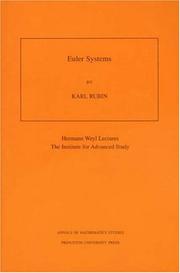
ISBN: 0691050759 1400865204 9781400865208 0691050767 9780691050768 9780691050751 9780691050768 Year: 2014 Publisher: Princeton, NJ
Abstract | Keywords | Export | Availability | Bookmark
 Loading...
Loading...Choose an application
- Reference Manager
- EndNote
- RefWorks (Direct export to RefWorks)
One of the most exciting new subjects in Algebraic Number Theory and Arithmetic Algebraic Geometry is the theory of Euler systems. Euler systems are special collections of cohomology classes attached to p-adic Galois representations. Introduced by Victor Kolyvagin in the late 1980's in order to bound Selmer groups attached to p-adic representations, Euler systems have since been used to solve several key problems. These include certain cases of the Birch and Swinnerton-Dyer Conjecture and the Main Conjecture of Iwasawa Theory. Because Selmer groups play a central role in Arithmetic Algebraic Geometry, Euler systems should be a powerful tool in the future development of the field. Here, in the first book to appear on the subject, Karl Rubin presents a self-contained development of the theory of Euler systems. Rubin first reviews and develops the necessary facts from Galois cohomology. He then introduces Euler systems, states the main theorems, and develops examples and applications. The remainder of the book is devoted to the proofs of the main theorems as well as some further speculations. The book assumes a solid background in algebraic Number Theory, and is suitable as an advanced graduate text. As a research monograph it will also prove useful to number theorists and researchers in Arithmetic Algebraic Geometry.
Algebraic number theory. --- p-adic numbers. --- Numbers, p-adic --- Number theory --- p-adic analysis --- Galois cohomology --- Cohomologie galoisienne. --- Algebraic number theory --- p-adic numbers --- Abelian extension. --- Abelian variety. --- Absolute Galois group. --- Algebraic closure. --- Barry Mazur. --- Big O notation. --- Birch and Swinnerton-Dyer conjecture. --- Cardinality. --- Class field theory. --- Coefficient. --- Cohomology. --- Complex multiplication. --- Conjecture. --- Corollary. --- Cyclotomic field. --- Dimension (vector space). --- Divisibility rule. --- Eigenvalues and eigenvectors. --- Elliptic curve. --- Error term. --- Euler product. --- Euler system. --- Exact sequence. --- Existential quantification. --- Field of fractions. --- Finite set. --- Functional equation. --- Galois cohomology. --- Galois group. --- Galois module. --- Gauss sum. --- Global field. --- Heegner point. --- Ideal class group. --- Integer. --- Inverse limit. --- Inverse system. --- Karl Rubin. --- Local field. --- Mathematical induction. --- Maximal ideal. --- Modular curve. --- Modular elliptic curve. --- Natural number. --- Orthogonality. --- P-adic number. --- Pairing. --- Principal ideal. --- R-factor (crystallography). --- Ralph Greenberg. --- Remainder. --- Residue field. --- Ring of integers. --- Scientific notation. --- Selmer group. --- Subgroup. --- Tate module. --- Taylor series. --- Tensor product. --- Theorem. --- Upper and lower bounds. --- Victor Kolyvagin. --- Courbes elliptiques --- Nombres, Théorie des
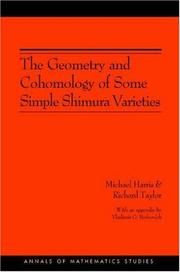
ISBN: 1400837200 9781400837205 0691090920 9780691090924 Year: 2001 Publisher: Princeton, NJ
Abstract | Keywords | Export | Availability | Bookmark
 Loading...
Loading...Choose an application
- Reference Manager
- EndNote
- RefWorks (Direct export to RefWorks)
This book aims first to prove the local Langlands conjecture for GLn over a p-adic field and, second, to identify the action of the decomposition group at a prime of bad reduction on the l-adic cohomology of the "simple" Shimura varieties. These two problems go hand in hand. The results represent a major advance in algebraic number theory, finally proving the conjecture first proposed in Langlands's 1969 Washington lecture as a non-abelian generalization of local class field theory. The local Langlands conjecture for GLn(K), where K is a p-adic field, asserts the existence of a correspondence, with certain formal properties, relating n-dimensional representations of the Galois group of K with the representation theory of the locally compact group GLn(K). This book constructs a candidate for such a local Langlands correspondence on the vanishing cycles attached to the bad reduction over the integer ring of K of a certain family of Shimura varieties. And it proves that this is roughly compatible with the global Galois correspondence realized on the cohomology of the same Shimura varieties. The local Langlands conjecture is obtained as a corollary. Certain techniques developed in this book should extend to more general Shimura varieties, providing new instances of the local Langlands conjecture. Moreover, the geometry of the special fibers is strictly analogous to that of Shimura curves and can be expected to have applications to a variety of questions in number theory.
Mathematics --- Shimura varieties. --- MATHEMATICS / Number Theory. --- Varieties, Shimura --- Arithmetical algebraic geometry --- Math --- Science --- Abelian variety. --- Absolute value. --- Algebraic group. --- Algebraically closed field. --- Artinian. --- Automorphic form. --- Base change. --- Bijection. --- Canonical map. --- Codimension. --- Coefficient. --- Cohomology. --- Compactification (mathematics). --- Conjecture. --- Corollary. --- Dimension (vector space). --- Dimension. --- Direct limit. --- Division algebra. --- Eigenvalues and eigenvectors. --- Elliptic curve. --- Embedding. --- Equivalence class. --- Equivalence of categories. --- Existence theorem. --- Field of fractions. --- Finite field. --- Function field. --- Functor. --- Galois cohomology. --- Galois group. --- Generic point. --- Geometry. --- Hasse invariant. --- Infinitesimal character. --- Integer. --- Inverse system. --- Isomorphism class. --- Lie algebra. --- Local class field theory. --- Maximal torus. --- Modular curve. --- Moduli space. --- Monic polynomial. --- P-adic number. --- Prime number. --- Profinite group. --- Residue field. --- Ring of integers. --- Separable extension. --- Sheaf (mathematics). --- Shimura variety. --- Simple group. --- Special case. --- Spectral sequence. --- Square root. --- Subset. --- Tate module. --- Theorem. --- Transcendence degree. --- Unitary group. --- Valuative criterion. --- Variable (mathematics). --- Vector space. --- Weil group. --- Weil pairing. --- Zariski topology.
Book
ISBN: 0691138214 1400837111 0691138222 9780691138220 9781400837113 9780691138213 Year: 2008 Publisher: Princeton, NJ
Abstract | Keywords | Export | Availability | Bookmark
 Loading...
Loading...Choose an application
- Reference Manager
- EndNote
- RefWorks (Direct export to RefWorks)
In 1970, Phillip Griffiths envisioned that points at infinity could be added to the classifying space D of polarized Hodge structures. In this book, Kazuya Kato and Sampei Usui realize this dream by creating a logarithmic Hodge theory. They use the logarithmic structures begun by Fontaine-Illusie to revive nilpotent orbits as a logarithmic Hodge structure. The book focuses on two principal topics. First, Kato and Usui construct the fine moduli space of polarized logarithmic Hodge structures with additional structures. Even for a Hermitian symmetric domain D, the present theory is a refinement of the toroidal compactifications by Mumford et al. For general D, fine moduli spaces may have slits caused by Griffiths transversality at the boundary and be no longer locally compact. Second, Kato and Usui construct eight enlargements of D and describe their relations by a fundamental diagram, where four of these enlargements live in the Hodge theoretic area and the other four live in the algebra-group theoretic area. These two areas are connected by a continuous map given by the SL(2)-orbit theorem of Cattani-Kaplan-Schmid. This diagram is used for the construction in the first topic.
Hodge theory. --- Logarithms. --- Logs (Logarithms) --- Algebra --- Complex manifolds --- Differentiable manifolds --- Geometry, Algebraic --- Homology theory --- Algebraic group. --- Algebraic variety. --- Analytic manifold. --- Analytic space. --- Annulus (mathematics). --- Arithmetic group. --- Atlas (topology). --- Canonical map. --- Classifying space. --- Coefficient. --- Cohomology. --- Compactification (mathematics). --- Complex manifold. --- Complex number. --- Congruence subgroup. --- Conjecture. --- Connected component (graph theory). --- Continuous function. --- Convex cone. --- Degeneracy (mathematics). --- Diagram (category theory). --- Differential form. --- Direct image functor. --- Divisor. --- Elliptic curve. --- Equivalence class. --- Existential quantification. --- Finite set. --- Functor. --- Geometry. --- Hodge structure. --- Homeomorphism. --- Homomorphism. --- Inverse function. --- Iwasawa decomposition. --- Local homeomorphism. --- Local ring. --- Local system. --- Logarithmic. --- Maximal compact subgroup. --- Modular curve. --- Modular form. --- Moduli space. --- Monodromy. --- Monoid. --- Morphism. --- Natural number. --- Nilpotent orbit. --- Nilpotent. --- Open problem. --- Open set. --- P-adic Hodge theory. --- P-adic number. --- Point at infinity. --- Proper morphism. --- Pullback (category theory). --- Quotient space (topology). --- Rational number. --- Relative interior. --- Ring (mathematics). --- Ring homomorphism. --- Scientific notation. --- Set (mathematics). --- Sheaf (mathematics). --- Smooth morphism. --- Special case. --- Strong topology. --- Subgroup. --- Subobject. --- Subset. --- Surjective function. --- Tangent bundle. --- Taylor series. --- Theorem. --- Topological space. --- Topology. --- Transversality (mathematics). --- Two-dimensional space. --- Vector bundle. --- Vector space. --- Weak topology.
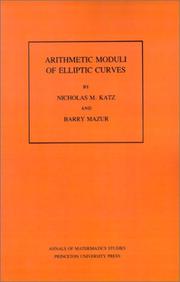
ISBN: 0691083525 0691083495 1400881714 Year: 2016 Publisher: Princeton, NJ : Princeton University Press,
Abstract | Keywords | Export | Availability | Bookmark
 Loading...
Loading...Choose an application
- Reference Manager
- EndNote
- RefWorks (Direct export to RefWorks)
This work is a comprehensive treatment of recent developments in the study of elliptic curves and their moduli spaces. The arithmetic study of the moduli spaces began with Jacobi's "Fundamenta Nova" in 1829, and the modern theory was erected by Eichler-Shimura, Igusa, and Deligne-Rapoport. In the past decade mathematicians have made further substantial progress in the field. This book gives a complete account of that progress, including not only the work of the authors, but also that of Deligne and Drinfeld.
Curves, Elliptic --- Moduli theory --- Theory of moduli --- Functions of several complex variables --- Elliptic curves --- Curves, Algebraic --- Geometry, Algebraic --- 511.3 --- Analytic spaces --- Algebraic geometry --- Geometry --- 511.3 Analytical, additive and other number-theory problems. Diophantine approximations --- Analytical, additive and other number-theory problems. Diophantine approximations --- Ordered algebraic structures --- Curves, Elliptic. --- Moduli theory. --- Geometry, Algebraic. --- Abelian variety. --- Addition. --- Algebraic variety. --- Algebraically closed field. --- Ambient space. --- Arithmetic. --- Axiom. --- Barry Mazur. --- Base change. --- Calculation. --- Canonical map. --- Change of base. --- Closed immersion. --- Coefficient. --- Coherent sheaf. --- Cokernel. --- Commutative property. --- Congruence relation. --- Coprime integers. --- Corollary. --- Cusp form. --- Cyclic group. --- Dense set. --- Diagram (category theory). --- Dimension. --- Discrete valuation ring. --- Disjoint union. --- Divisor. --- Eigenfunction. --- Elliptic curve. --- Empty set. --- Factorization. --- Field of fractions. --- Finite field. --- Finite group. --- Finite morphism. --- Free module. --- Functor. --- Group (mathematics). --- Integer. --- Irreducible component. --- Level structure. --- Local ring. --- Maximal ideal. --- Modular curve. --- Modular equation. --- Modular form. --- Moduli space. --- Morphism of schemes. --- Morphism. --- Neighbourhood (mathematics). --- Noetherian. --- One-parameter group. --- Open problem. --- Prime factor. --- Prime number. --- Prime power. --- Q.E.D. --- Regularity theorem. --- Representation theory. --- Residue field. --- Riemann hypothesis. --- Smoothness. --- Special case. --- Subgroup. --- Subring. --- Subset. --- Theorem. --- Topology. --- Two-dimensional space. --- Zariski topology.
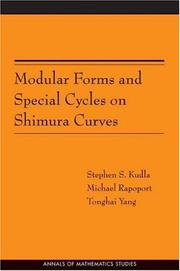
ISBN: 1299401023 1400837162 0691125511 0691125503 9781400837168 9780691125503 9780691125510 9781299401020 Year: 2006 Publisher: Princeton, NJ
Abstract | Keywords | Export | Availability | Bookmark
 Loading...
Loading...Choose an application
- Reference Manager
- EndNote
- RefWorks (Direct export to RefWorks)
Modular Forms and Special Cycles on Shimura Curves is a thorough study of the generating functions constructed from special cycles, both divisors and zero-cycles, on the arithmetic surface "M" attached to a Shimura curve "M" over the field of rational numbers. These generating functions are shown to be the q-expansions of modular forms and Siegel modular forms of genus two respectively, valued in the Gillet-Soulé arithmetic Chow groups of "M". The two types of generating functions are related via an arithmetic inner product formula. In addition, an analogue of the classical Siegel-Weil formula identifies the generating function for zero-cycles as the central derivative of a Siegel Eisenstein series. As an application, an arithmetic analogue of the Shimura-Waldspurger correspondence is constructed, carrying holomorphic cusp forms of weight 3/2 to classes in the Mordell-Weil group of "M". In certain cases, the nonvanishing of this correspondence is related to the central derivative of the standard L-function for a modular form of weight 2. These results depend on a novel mixture of modular forms and arithmetic geometry and should provide a paradigm for further investigations. The proofs involve a wide range of techniques, including arithmetic intersection theory, the arithmetic adjunction formula, representation densities of quadratic forms, deformation theory of p-divisible groups, p-adic uniformization, the Weil representation, the local and global theta correspondence, and the doubling integral representation of L-functions.
Arithmetical algebraic geometry. --- Shimura varieties. --- Varieties, Shimura --- Algebraic geometry, Arithmetical --- Arithmetic algebraic geometry --- Diophantine geometry --- Geometry, Arithmetical algebraic --- Geometry, Diophantine --- Arithmetical algebraic geometry --- Number theory --- Abelian group. --- Addition. --- Adjunction formula. --- Algebraic number theory. --- Arakelov theory. --- Arithmetic. --- Automorphism. --- Bijection. --- Borel subgroup. --- Calculation. --- Chow group. --- Coefficient. --- Cohomology. --- Combinatorics. --- Compact Riemann surface. --- Complex multiplication. --- Complex number. --- Cup product. --- Deformation theory. --- Derivative. --- Dimension. --- Disjoint union. --- Divisor. --- Dual pair. --- Eigenfunction. --- Eigenvalues and eigenvectors. --- Eisenstein series. --- Elliptic curve. --- Endomorphism. --- Equation. --- Explicit formulae (L-function). --- Fields Institute. --- Formal group. --- Fourier series. --- Fundamental matrix (linear differential equation). --- Galois group. --- Generating function. --- Green's function. --- Group action. --- Induced representation. --- Intersection (set theory). --- Intersection number. --- Irreducible component. --- Isomorphism class. --- L-function. --- Laurent series. --- Level structure. --- Line bundle. --- Local ring. --- Mathematical sciences. --- Mathematics. --- Metaplectic group. --- Modular curve. --- Modular form. --- Modularity (networks). --- Moduli space. --- Multiple integral. --- Number theory. --- Numerical integration. --- Orbifold. --- Orthogonal complement. --- P-adic number. --- Pairing. --- Prime factor. --- Prime number. --- Pullback (category theory). --- Pullback (differential geometry). --- Pullback. --- Quadratic form. --- Quadratic residue. --- Quantity. --- Quaternion algebra. --- Quaternion. --- Quotient stack. --- Rational number. --- Real number. --- Residue field. --- Riemann zeta function. --- Ring of integers. --- SL2(R). --- Scientific notation. --- Shimura variety. --- Siegel Eisenstein series. --- Siegel modular form. --- Special case. --- Standard L-function. --- Subgroup. --- Subset. --- Summation. --- Tensor product. --- Test vector. --- Theorem. --- Three-dimensional space (mathematics). --- Topology. --- Trace (linear algebra). --- Triangular matrix. --- Two-dimensional space. --- Uniformization. --- Valuative criterion. --- Whittaker function.
Book
ISBN: 9786613883919 1400845645 1283571463 9781400845644 0691155925 9780691155920 0691155917 9780691155913 9780691155913 9780691155920 9781283571463 Year: 2012 Publisher: Princeton, NJ
Abstract | Keywords | Export | Availability | Bookmark
 Loading...
Loading...Choose an application
- Reference Manager
- EndNote
- RefWorks (Direct export to RefWorks)
This comprehensive account of the Gross-Zagier formula on Shimura curves over totally real fields relates the heights of Heegner points on abelian varieties to the derivatives of L-series. The formula will have new applications for the Birch and Swinnerton-Dyer conjecture and Diophantine equations. The book begins with a conceptual formulation of the Gross-Zagier formula in terms of incoherent quaternion algebras and incoherent automorphic representations with rational coefficients attached naturally to abelian varieties parametrized by Shimura curves. This is followed by a complete proof of its coherent analogue: the Waldspurger formula, which relates the periods of integrals and the special values of L-series by means of Weil representations. The Gross-Zagier formula is then reformulated in terms of incoherent Weil representations and Kudla's generating series. Using Arakelov theory and the modularity of Kudla's generating series, the proof of the Gross-Zagier formula is reduced to local formulas. The Gross-Zagier Formula on Shimura Curves will be of great use to students wishing to enter this area and to those already working in it.
Shimura varieties. --- Arithmetical algebraic geometry. --- Automorphic forms. --- Quaternions. --- Algebra, Universal --- Algebraic fields --- Curves --- Surfaces --- Numbers, Complex --- Vector analysis --- Automorphic functions --- Forms (Mathematics) --- Algebraic geometry, Arithmetical --- Arithmetic algebraic geometry --- Diophantine geometry --- Geometry, Arithmetical algebraic --- Geometry, Diophantine --- Number theory --- Varieties, Shimura --- Arithmetical algebraic geometry --- Arakelov theory. --- Benedict Gross. --- Don Zagier. --- EichlerГhimura theory. --- Eisenstein series. --- GrossКagier formula. --- Heegner point. --- Hodge bundle. --- Hodge index theorem. --- L-series. --- MordellЗeil group. --- NeronДate height. --- RankinГelberg L-function. --- Schwartz function. --- Shimizu lifting. --- Shimura curve. --- Shimura curves. --- SiegelЗeil formula. --- Waldspurger formula. --- Weil representation. --- abelian varieties. --- analytic kernel function. --- analytic kernel. --- degenerate Schwartz function. --- discrete series. --- generating series. --- geometric kernel. --- height series. --- holomorphic kernel function. --- holomorphic projection. --- incoherent Eisenstein series. --- incoherent automorphic representation. --- incoherent quaternion algebra. --- kernel function. --- kernel identity. --- local height. --- modular curve. --- modularity. --- multiplicity function. --- non-archimedean local field. --- non-degenerate quadratic space. --- ordinary component. --- orthogonal space. --- projector. --- pull-back formula. --- ramified quadratic extension. --- supersingular component. --- superspecial component. --- theta function. --- theta liftings. --- theta series. --- trace identity. --- un-normalized kernel function. --- unramified quadratic extension.
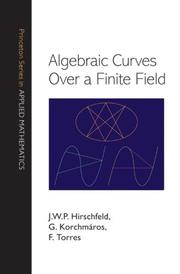
ISBN: 1400847419 9781400847419 1306988608 9781306988605 9781400847426 1400847427 0691096791 9780691096797 9780691096797 Year: 2013 Publisher: Princeton, NJ
Abstract | Keywords | Export | Availability | Bookmark
 Loading...
Loading...Choose an application
- Reference Manager
- EndNote
- RefWorks (Direct export to RefWorks)
This book provides an accessible and self-contained introduction to the theory of algebraic curves over a finite field, a subject that has been of fundamental importance to mathematics for many years and that has essential applications in areas such as finite geometry, number theory, error-correcting codes, and cryptology. Unlike other books, this one emphasizes the algebraic geometry rather than the function field approach to algebraic curves. The authors begin by developing the general theory of curves over any field, highlighting peculiarities occurring for positive characteristic and requiring of the reader only basic knowledge of algebra and geometry. The special properties that a curve over a finite field can have are then discussed. The geometrical theory of linear series is used to find estimates for the number of rational points on a curve, following the theory of Stöhr and Voloch. The approach of Hasse and Weil via zeta functions is explained, and then attention turns to more advanced results: a state-of-the-art introduction to maximal curves over finite fields is provided; a comprehensive account is given of the automorphism group of a curve; and some applications to coding theory and finite geometry are described. The book includes many examples and exercises. It is an indispensable resource for researchers and the ideal textbook for graduate students.
Curves, Algebraic. --- Finite fields (Algebra) --- Modular fields (Algebra) --- Algebra, Abstract --- Algebraic fields --- Galois theory --- Modules (Algebra) --- Algebraic curves --- Algebraic varieties --- Abelian group. --- Abelian variety. --- Affine plane. --- Affine space. --- Affine variety. --- Algebraic closure. --- Algebraic curve. --- Algebraic equation. --- Algebraic extension. --- Algebraic function. --- Algebraic geometry. --- Algebraic integer. --- Algebraic number field. --- Algebraic number theory. --- Algebraic number. --- Algebraic variety. --- Algebraically closed field. --- Applied mathematics. --- Automorphism. --- Birational invariant. --- Characteristic exponent. --- Classification theorem. --- Clifford's theorem. --- Combinatorics. --- Complex number. --- Computation. --- Cyclic group. --- Cyclotomic polynomial. --- Degeneracy (mathematics). --- Degenerate conic. --- Divisor (algebraic geometry). --- Divisor. --- Dual curve. --- Dual space. --- Elliptic curve. --- Equation. --- Fermat curve. --- Finite field. --- Finite geometry. --- Finite group. --- Formal power series. --- Function (mathematics). --- Function field. --- Fundamental theorem. --- Galois extension. --- Galois theory. --- Gauss map. --- General position. --- Generic point. --- Geometry. --- Homogeneous polynomial. --- Hurwitz's theorem. --- Hyperelliptic curve. --- Hyperplane. --- Identity matrix. --- Inequality (mathematics). --- Intersection number (graph theory). --- Intersection number. --- J-invariant. --- Line at infinity. --- Linear algebra. --- Linear map. --- Mathematical induction. --- Mathematics. --- Menelaus' theorem. --- Modular curve. --- Natural number. --- Number theory. --- Parity (mathematics). --- Permutation group. --- Plane curve. --- Point at infinity. --- Polar curve. --- Polygon. --- Polynomial. --- Power series. --- Prime number. --- Projective plane. --- Projective space. --- Quadratic transformation. --- Quadric. --- Resolution of singularities. --- Riemann hypothesis. --- Scalar multiplication. --- Scientific notation. --- Separable extension. --- Separable polynomial. --- Sign (mathematics). --- Singular point of a curve. --- Special case. --- Subgroup. --- Sylow theorems. --- System of linear equations. --- Tangent. --- Theorem. --- Transcendence degree. --- Upper and lower bounds. --- Valuation ring. --- Variable (mathematics). --- Vector space.
| Listing 1 - 7 of 7 |
Sort by
|

 Search
Search Feedback
Feedback About UniCat
About UniCat  Help
Help News
News